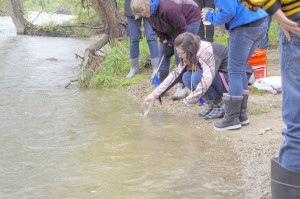 By David Fleet
By David Fleet
Editor
Last month about 40 Chinook salmon set out on a two-year jouney thanks to the efforts of a local school.
On May 4, Peggy Miller-Zelinko’s science class at Brandon Academy of Arts & Sciences released their salmon from the shore of the Clinton River in Rochester Hills, a local watershed that feeds one of the Great Lakes.
Thanks to a grant from the Ortonville Rotary Club, students received Chinook salmon eggs last fall from Wolf Lake State Fish Hatchery in Mattawan, Van Buren County. The project is part of the Salmon in the Classroom program supervised by the Michigan Department of Natural Resources.
Miller-Zelinko follows strict guidelines outlined by the DNR, which include keeping the eggs in a 50-gallon tank with 47-degree treated water. The water is continually agitated to simulate a moving waterway. Each school that participates in the Salmon in the Classroom program receives a permit to release the fish from the MDNR.
“It’s been a great learning experience for the students,” said Miller-Zelinko. The students are really into the project and keep watch over the eggs and now small salmon each day.”
The Salmon in the Classroom program incorporates more than 300 Michigan schools. The learning experience provides students the opportunity to raise, care for, and maintain the salmon in their classroom from fall until spring.
Jay Wesley is the Lake Michigan basin coordinator for the Michigan Department of Natural Resources Fisheries said the population of the Chinook salmon has declined in recent years.
“Due to low alewives numbers, (salmon) stocking reductions and natural reproduction failures from a series of harsh winters, the salmon population in Lake Michigan has declined since 2014,” said Wesley. “However, there has been an upturn in the population in 2016.”
“Still there’s plenty of salmon to catch out there,” he added. “We have decreased the number of eggs provided to classrooms to make management easier for teachers and DNR. Even if we reduce our (salmon) stocking we’ll have a plentiful egg source.”
The salmon average a weight of 30 to 40 pounds and 38 inches in length when fully grown.
